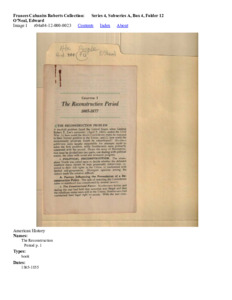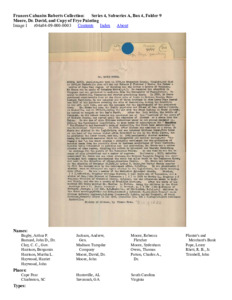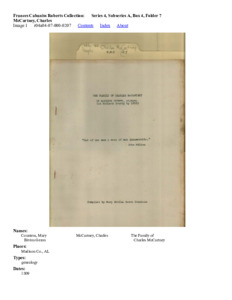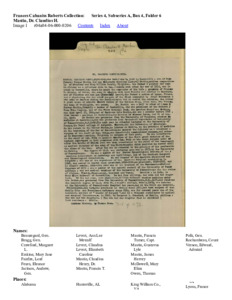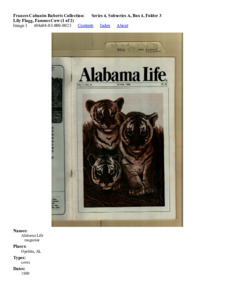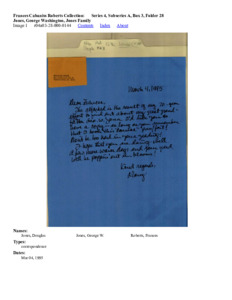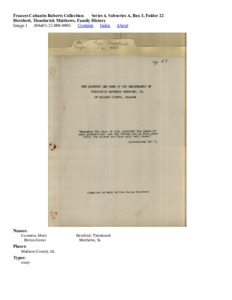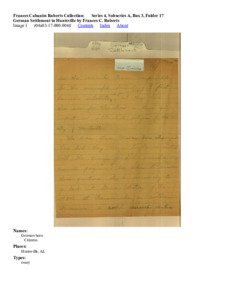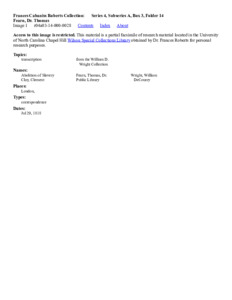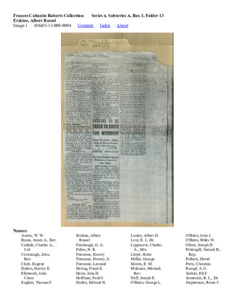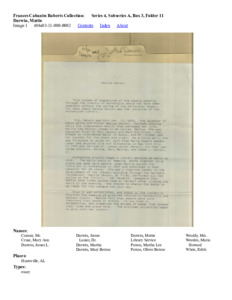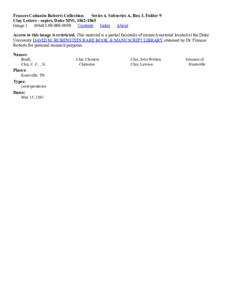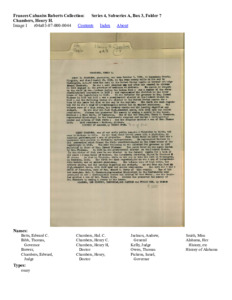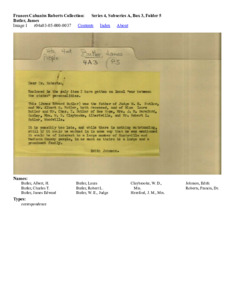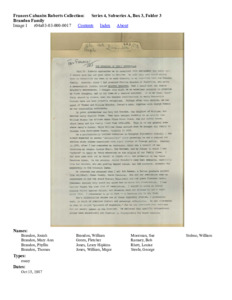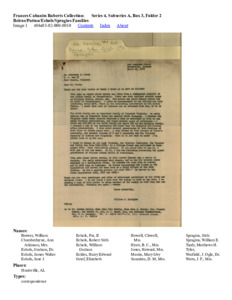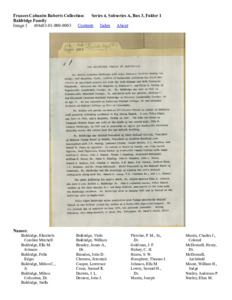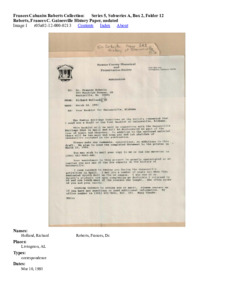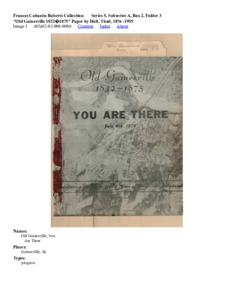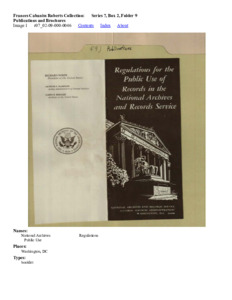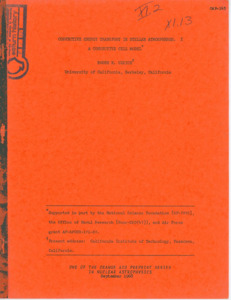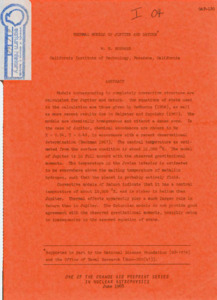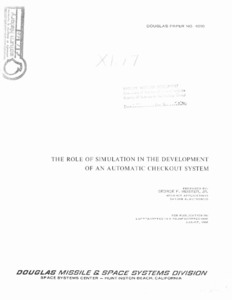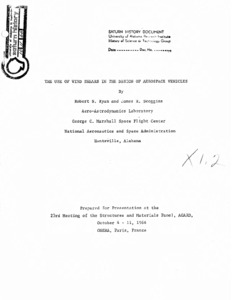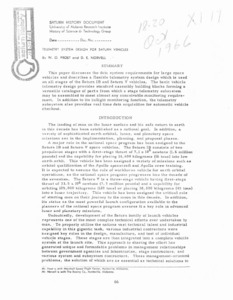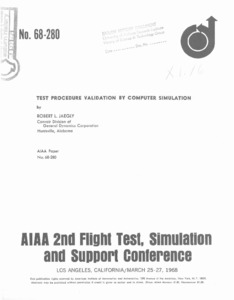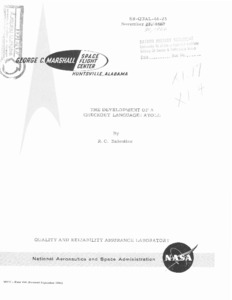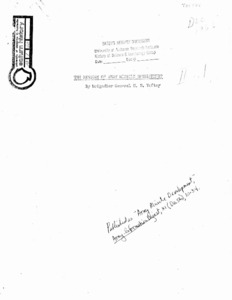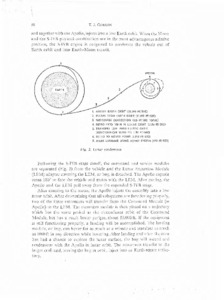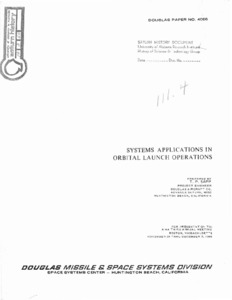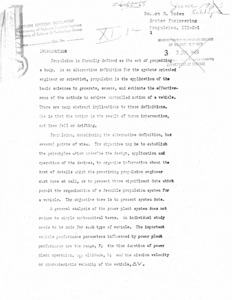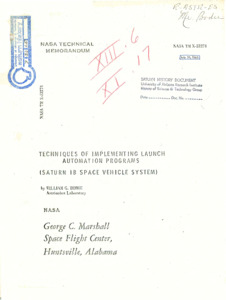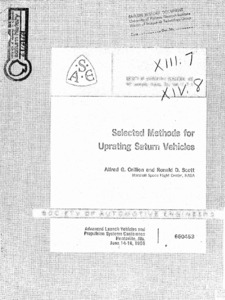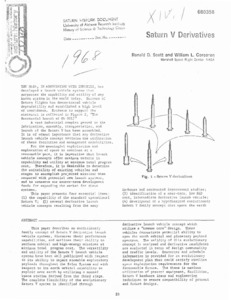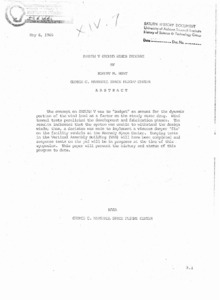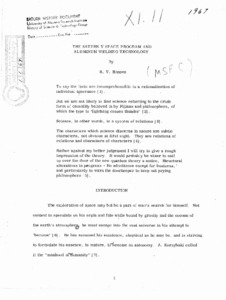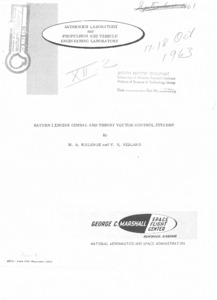
Browse Items (165 total)
Sort by:
-
Roberts, Frances C. Gainesville History Paper, undated
Contains a correspondence between Richard Holland and Frances C. Roberts regarding unspecified editing suggestions to a tourism booklet. Contains tourism booklet in essay-form. -
"Old Gainesville 1832–1875" Paper by Holt, Thad, 1876 -1955
This folder contains the Old Gainesville paper by Thaddeus Holt, numerous photographs, paintings, papers and scripts. -
Publications and Brochures
This section contains information booklets from the National Archives and Records Service as well as correspondence, pamphlets and post cards from Alpine Cave. -
Convective Energy Transport in Stellar Atmospheres: A Convective Cell Model.
One of the Orange Aid Preprint Series in Nuclear Astrophysics, September 1968.; Supported in part by the National Science Foundation [GP-7976], the Office of Naval Research [Nonr-220(47)]. ; ABSTRACT: The motion in a convectively unstable region is expanded into an ensemble of convective cells. Each of these cells interacts with the surrounding medium according to the semiempirical model proposed by Turner (1963 ). Possible detailed models of the flow patterns within each cell are presented. The radius and velocity of these cells are given as functions of distance moved. The convective flux and rms velocity are given as averages over the ensemble of cells. As in the standard mixing length theory the principle uncertainty remains the average initial radius of the cells. -
"Thermal models of Jupiter and Saturn"
One of the orange Aid Preprint Series in Nuclear Astrophysics by W. B. Hubbard, California Institute of Technology, Pasadena, California.; Argues that the Saturnian models are flawed as their predictions do not line up with detected gravitational events. -
"The role of simulation in the development of an automatic checkout system"
For publication in Luftfahrttechnik Raumfahrttechnik. Discusses the uses and advantages to using simulations. -
"The use of wind shears in the design of aerospace vehicles."
Prepared for presentation at the 23rd Meeting of the Structures and Materials Panel, AGARD, October 4-11,1966, ONERA, Paris, France.; ABSTRACT: The relative influence of various wind profile properties and disturbances on launch vehicle flight dynamic response is studied. Particular emphasis is placed on the influence of wind shears and turbulence on dynamic response during the boost phase of the flight. Four hundred and seven individual detailed (Jimsphere) wind profiles are the primary wind inputs for this analysis. Time response of the vehicle to each profile is computed and a statistical evaluation of the results made. Results are obtained for the Saturn V space vehicle and conclusions drawn as to the relative influence of wind shears and turbulence vs the degree of refinement of the dynamic model of the space vehicle. -
"Telemetry system design for Saturn vehicles."
This paper discusses the data system requirements for large space vehicles and describes a flexible telemetry system design which is used on all stages of the Saturn IB and Saturn V vehicles. The basic vehicle telemetry design provides standard assembly building blocks forming a versatile catalogue of parts from which a stage telemetry subsystem may be assembled to meet almost any conceivable monitoring requirement. In addition to its inflight monitoring function, the telemetry subsystem also provides real time data acquisition for automatic vehicle checkout. -
"Test procedure validation by computer simulation."
Digital computer simulation of the Saturn I Instrument Unit electrical networks was accomplished using the Discrete Network Simulation programs. The schematics were analyzed and a logic model prepared which consisted of a series of Boolean equations. The test procedures, which are written in the Acceptance, Test, or Launch Language (ATOLL), consist of a sequential set of computer instructions for the RCA llOA checkout computer to control the operation of the electrical networks. The procedures also contain the predicted results for each operation. The driving functions for the simulation of the model are generated from the ATOLL test tape by the Input Generator Program. The time sequenced operation of the networks is indicatedby the output from the simulation program in addition to the number of times each component in the system changes state. The results of the simulation are compared to the test procedure predictions on the ATOLL tape by the Comparator Program and any differences are listed. The Comparator Program also lists any component which did not change state at least once. -
"The development of a checkout language : ATOLL."
ATOLL was developed to fulfill the requirements for a common computer language that could be used by the test engineers for launch and factory checkout. "ATOLL" is the abbreviated name for Acceptance, Test, Or Launch Language. -
"The development of a bonded common bulkhead for Saturn."
A Part of the development of the Saturn S-IV/S-IVB stage the Douglas Aircraft Company has pioneered in the development of the cryogenic common bulkhead. The term common bulkhead is derived from the design function of the bulkhead, which is to separate the two cryogenics, liquid hydrogen and liquid oxygen, in a single tank, thereby shortening the stage and eliminating the necessity for two separate bulkheads and the associated interstage structure. The common bulkhead is structurally adequate to withstand both the thermal and the pressure loads from both the hydrogen and the oxygen tanks, and it has sufficient insulation properties to prevent the liquid hydrogen from freezing the liquid oxygen. Another benefit from the common bulkhead is that it permits a reduction in the total length of the vehicle, thereby reducing the bending moments. -
"The history of Army missile development."
Published as "Army Missile Development," Army Information Digest, XI. Establishes the development and history of weaponized rocket ordenance. -
"Survey of Saturn stage test and checkout computer program development."
This survey of the Saturn Stage Test and Checkout Computer Program Development contains a summary description of the systems developed for factory and static test of the stages of the SATURN IB and SATURN V Vehicles. The responsibilities of the MSFC and stage contractor organizations that are involved in test and checkout computer program development are briefly described. The test and checkout hardware and software (computer program) systems are given for each stage and for each site where tests are conducted. The systems and procedures that are used for program production verification, documentation, and change control required for the implementation of planned computer programs are included. Notes are included in the report to indicate what material is missing or incomplete. No attempt has been made to draw any conclusions regarding the automatic test and checkout systems being developed for each stage and the manner in which the efforts are organized, scheduled, and implemented. This document has been based on material provided by stage contractors and by components of MSFC through May 1, 1966. COMPUTER SYSTEMS SECTION. VEHICLE SYSTEMS INTEGRATION BRANCH. VEHICLE SYSTEMS CHECKOUT DIVISION.; SR-QUAL-66-3. -
"A survey of propulsion problems as related to space vehicle design."
Incomplete document. Displays errors in space-vehicle design as they relate to space travel. -
"Systems applications in orbital launch operations."
The objective is to examine the technical requirements and feasibility of conducting orbital launch operations with systems now in the development phase. In order to maintain realistic constraints on the analysis, the Saturn S-IVB stage has been used as an example of present stage technology. The requirements, procedures and complexity of operations for orbital assembly and launch are discussed. The primary design requirement for orbital assembly and launch operations is increased orbital stay time (from hours to days or weeks). -
"System engineering propulsion, III-C-1."
Page numbering is inconsistent; there are no pages numbered 14 - 17. Some pages have handwritten numbers, others have no numbers at all.; The print quality of many pages is poor. Discusses the definition and function of propulsion as well as how to most effectively employ it . -
"Techniques of implementing launch automation programs" (Saturn IB space vehicle system).
This paper identifies the methods and equipment through which automation is becoming a major factor in testing and launching Saturn IB space vehicles. The merits of a digital guidance computer and its impact in extending automated checkout are stressed; also a logical basis is established for computer and manual test control. Hardware and software elements of the automated system are described, and details pertaining to reliability are emphasized. A concluding appraisal suggests that automation will play an expanding role in future test and launch operations. -
"Selected methods for uprating Saturn vehicles."
This paper will discuss selected methods for increasing the Saturn launch vehicle payload capabilities. These methods involve system changes or additions that give large step performance'increases aver those which can be obtained by product improvements. The selected philosophy of approach and the established designed systems wil1,be described, as well as anticipatedsystem concepts that may be used to increase the Saturn vehicles' capabilities. -
"Saturn V derivatives."
This paper desciibes an evolutionary family concept of !h turn V derivative launch vehicle systems, discusses their performance capabilities, and outlines their ability to perform orbital and hlgh-energy missions at minimum total program cost. -
"Saturn V ground winds program."
The concept on Saturn V was to "budget" an amount for the dynamic portion of the wind load as a factor on the steady state drag. Wind tunnel tests paralleled the development and fabrication phases. The results indicated that the system was unable to withstand the design winds; thus, a decision was made to implement a viscous damper "fix" on the facility vehicle at the Kennedy Space Center. Damping tests in the Vertical Assembly Building (VAB) will have been completed and response tests on the pad will be in progress at the time of this symposium. This paper will present the history and status of this program to date. -
"Saturn V space program and aluminum welding technology."
This paper discusses the flaws and limitations with welding technology, specifically with the techniques involved. -
"Saturn I engine gimbal and thrust vector control systems."
The hydraulic systems for the two-stage block II Saturn I vehicle are described with the evolution of their development. -
"Saturn instrumentation systems."
Paper to be presented at the Third International Flight Test Instrumentation Symposium College of Aeronautics. A brief description of the Saturn vehicles is given, delineating the makeup of and differences between the Saturn I, Saturn IB, and Saturn V.
